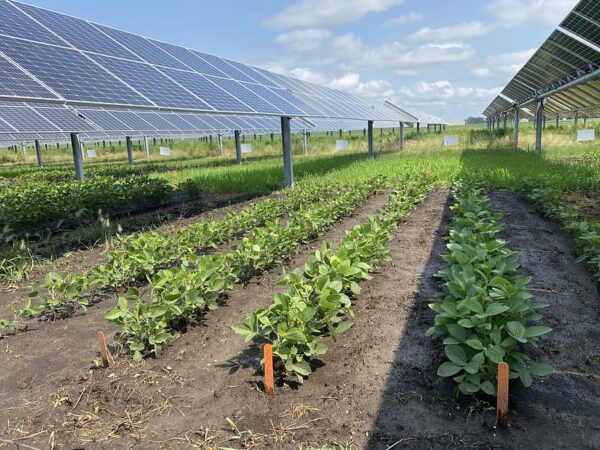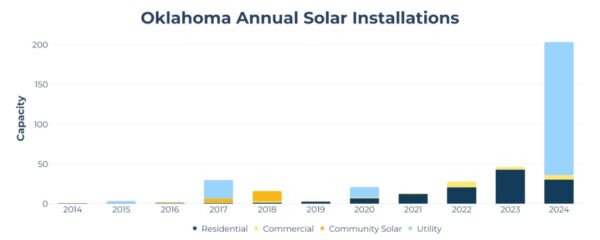With Oklahoma’s sudden surge in solar development, the House of Representatives passed a bill aimed at bringing harmony between renewable energy and the state’s farms and ranches.
A bill seeking for compatibility between Oklahoma’s agricultural industry and solar development is in the Senate after it passed the state’s House of Representatives.
The Oklahoma Agrivoltaics Act, or HB 2157, aims to enhance the state’s electrical generation capacity while supporting agricultural productivity through the development of renewable energy projects. The bill passed the House of Representatives with 73 voting in favor and 20 voting against it.
Agrivoltaics is the practice of co-locating solar facilities and agricultural production. Typically, the solar facilities are designed with raised profiles so that tractors and animals can pass under them, or by placing gaps in between rows to allow for co-located agricultural and solar production.
It is in the public’s best interest to “develop a legislative strategy designed to maintain agricultural productivity along with renewable energy development in a way that works in harmony with farming and ranching,” the bill says.
The bill establishes the Oklahoma Agrivoltaics Advisory Committee, a 17-member committee composed of members from an array of different sectors, including renewable energy, livestock production, Tribal Governments, farming, forestry, and electrical transmission and distribution.
This committee would be tasked with advising the Oklahoma Center for the Advancement of Science and Technology on policies and strategies that “promote the harmonious coexistence of renewable energy development and agricultural practices.”
Among its responsibilities tasked by the bill, the agrivoltaics committee would:
- identify existing tools and government initiatives designed to help in the siting and construction of agrivoltaic projects and agriculture-incorporated transmission systems, including agritourism and outdoor recreation leases;
- develop policy options for lawmakers to encourage maintaining agricultural productivity with renewable energy projects and transmission systems.
- facilitate educational and advisory materials about agrivoltaics development in Oklahoma, providing strategies to both landowners and the renewable energy industry on encouraging renewable energy development in a manner that supports farming, ranching and forestry, including agritourism and outdoor recreation leases; and
- identify and recommend further areas of research.
Additionally, the bill creates the Oklahoma Agrivoltaics Cash Revolving Fund, which would be used to finance the agrivoltaic initiatives outlined in the act. This fund would be a continuous source of funding, allowing the Oklahoma Center for the Advancement of Science and Technology to budget and expend resources as needed for implementing these initiatives. The act emphasizes the importance of integrating renewable energy development with agricultural and forestry practices, including agritourism and outdoor recreation, to ensure that both sectors can thrive together.
Ranching holds particular promise to co-exist with solar, as photovoltaic shade has been shown to benefit forage, especially in arid regions. This creates better soil composition for cows, sheep and other farm animals to graze, while creating a more natural soil composition around the panels, according to an Oregon State study.
(Read: The economics of solar grazing & The evolving art and science of agrivoltaics)
Oklahoma’s electrical generation capacity must increase significantly over time to maintain strong economic growth and to improve its citizens’ quality of life, according to the legislation. “Along with our traditional abundance of natural gas generation, the growth of various renewable energy projects could significantly expand the renewable energy footprint which could potentially impact agriculture production,” the bill says.
Authored by Republicans Rep. Mike Dobrinski and Sen. Roland Pederson, the bill notes that agrivoltaics can minimize renewable projects’ impact on farming and ranching and “in some cases assist in improving overall agriculture productivity.”
Studies from the University of Arizona show that agrivoltaics offers mutual benefits, particularly in sunny and arid climates, where the solar arrays provide shade for crops, and crops absorb heat and water, improving panel efficiency and durability.

The Oklahoma Agrivoltaics Act is currently in the Energy Committee and will be voted on by the Senate once the bill goes through its third reading. The act includes an emergency clause, allowing it to take effect immediately upon passage and approval.
Oklahoma is ranked 4th in the nation for its 86,000 farms spanning more than 35 million acres, according to the Oklahoma Farm Bureau Foundation. The agriculture industry employs more than 188,000 people in Oklahoma. By contrast, 947 people were employed in Oklahoma’s solar industry as of March 2025, according to Solar Energy Industries Association (SEIA).
Up to 83% of new solar development by 2040 is forecast to occur on farmland and ranchland, according to the American Farmland Trust. While Oklahoma ranks 41st in the country for solar capacity and gets just 0.55% of its electricity from solar, according to SEIA, the state’s solar is experiencing a surge in growth. According to solar intelligence firm, PV Intel, Oklahoma was one of fifteen states in which solar capacity grew by more than 50% in 2024.



